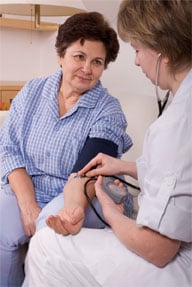Blood Clots at a Glance: Know Your Risk

Deep vein thrombosis (DVT) occurs when a blood clot develops in the deep veins of the leg. Although DVT itself is not fatal, the problem is that parts of the clot can break off and travel up to the lung arteries, causing a pulmonary embolism (PE), a condition that kills up to 180,000 Americans each year. Around 25 to 50 percent of DVT survivors develop a long-term complication, called "post-thrombotic syndrome," which causes chronic leg swelling, pain, heaviness and fatigue, and in severe cases disability and leg sores.
Up to 1 million Americans are affected by DVT or PE each year, and up to 600,000 are hospitalized. DVT risk increases as we age; however, the condition can occur at any age. The risk also increases for women during pregnancy or four to six weeks after delivery.
Why do blood clots develop? In general, blood clots originate in areas where there is sluggish blood flow, a tendency to clot quickly, or vein irritation or inflammation. Those at greatest risk have had recent surgery, an acute illness requiring hospitalization, cancer or a family history of blood clots.
DVT can be detected by using ultrasound and is typically treated with blood-thinning or anticoagulant medication. For major clots, doctors might use clot-busting medications and devices to soften and remove or surgically remove them. Although blood clots are common, most can be prevented through use of blood-thinning medications when patients are at higher risk.
The Vascular Disease Foundation, a national non-profit organization that provides educational information on vascular disease, provides these tips:
- If hospitalized or scheduled for surgery, talk to your physician about how to prevent DVT.
- Discuss the risks of birth control and estrogen hormone therapy with your doctor.
- If you travel long distances, whether by plane or by car, get up and walk every hour.
- Stop smoking.
- Maintain a healthy weight, and eat a healthy diet.
For more information, visit the Vascular Disease Foundation at www.vdf.org or call 888-833-4463.

No comments: